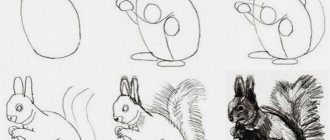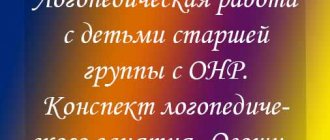Summary of a music lesson on listening to music “Three Miracles”
MBDOU d/s No. 3
Preparatory group for school
Lesson notes on listening to music
“Three Miracles” from the opera “The Tale of Tsar Saltan”
Musician/leader Nechaeva E.A.
Target:
Formation of artistic and aesthetic perception of fairy-tale images through the perception of music and poetry.
Tasks:
- Encourage children to express their thoughts and feelings through movement and music.
- To promote the development of figurative speech, the ability to look at illustrations to the works of A.S. Pushkin
- Develop children's cognitive and creative abilities.
- Develop a culture of listening to classical works
- Develop imagination, memory, ability to compare, analyze….
Equipment:
- Audio recording of musical works of three miracles: “Squirrel”, “33 Bogatyrs”, “The Swan Princess” from the opera “The Tale of Tsar Saltan” by N. Rimsky-Korsakov;
- musical instruments: metallophones, spoons, triangles.
- illustrations for “The Tale of Tsar Saltan.”
Musical material:
Songs “The Wind Walks on the Sea” by G. Struve, “A Tender Tale” by N. Gogin. Music movement “33 heroes”, “Swan Princess”. Orchestra "Belka".
Progress of the lesson
“Waltz-Fantasy” by M. Glinka is playing. Children enter the hall and sit on chairs.
Musical director:
Guys, of course, you know that music can tell us a lot.
Let's remember what the music we listened to in class told us about? Children:
Can tell fairy tales about nature, about human moods and feelings, about birds and animals.
Musical director:
Guys, do you like fairy tales? (Yes). I invite you to take a trip to a wonderful and amazing land of fairy tales. Want to? (Yes). Now we will perform a song, and you think about what fairy tale we found ourselves in.
Performance of the song “The Wind Walks on the Sea” by G. Struve.
Musical director:
Guys, what fairy tale have we found ourselves in? ("The Tale of Tsar Saltan")
Educator:
Its full title: “The Tale of Tsar Saltan, of his glorious and mighty hero Prince Gvidon Saltanovich, and of the beautiful Swan Princess.”
Educator:
Who is the author of the fairy tale?
(A.S. Pushkin). — What fairy tales of Pushkin do you know? (“The Tale of the Fisherman and the Fish”, “The Tale of the Golden Cockerel”, “The Tale of the Dead Princess and the Seven Knights”, “The Tale of the Priest and his Worker Balda”). Musical director:
Many composers wrote their musical works based on literary works.
An opera was written based on the plot of Pushkin’s fairy tale “The Tale of Tsar Saltan”. What is opera? Children:
This is a musical act in which they only sing.
Musical director: Who wrote this opera? (N. Rimsky - Korsakov) Musical director:
This is a great Russian composer. He wrote many works on fairy tales. In the opera “The Tale of Tsar Saltan” the plot is preserved as Pushkin invented it. But composer N.A. Rimsky-Korsakov composed amazing musical themes in order to show all of Pushkin’s heroes. One of the remarkable parts of the opera is a passage called “Three Miracles”, which took place in the unusual island city of Ledenets. Now we will listen to the musical theme, which depicts the city-island of Lollipop, on which the princess and the prince find themselves. Think about how he is depicted in music, imagine him and describe him.
Listening to an excerpt from the city of Lollipop
Musical director:
What music?
What does she represent? Children:
the music is solemn, majestic.
The overflow of water and the splashing of waves are depicted. The trumpet sounds. Musical director:
What three miracles happened in this unusual city of Ledenets?
Children:
Belka, 33 heroes, swan princess.
Musical director:
We will listen to a fragment about one of these miracles. Your task is to listen carefully and guess what miracle the composer wanted to tell us.
Children listen to the excerpt "Squirrel".
Musical director:
What is the nature of this music?
(light, airy, dance, light, etc.). What instrument leads the melody? (flute). What miracle was the composer talking about? (squirrel). Educator:
How did Pushkin describe this miracle?
Child:
A spruce tree grows in front of the palace, And under it is a crystal house; The squirrel sings songs and gnaws all the nuts. And the nuts are not simple, He puts all the golden shells in equal piles, And with a whistle he sings in front of all the people: Whether in the garden or in the vegetable garden. Musical director:
What song is at the heart of this piece? (Russian folk song “In the garden, in the vegetable garden”). Guys, let's take the instruments, create our own orchestra and perform this piece.
Orchestra "In the garden or in the vegetable garden."
Educator:
Again the shipmen went to Tsar Saltan and told him about the squirrel.
But then the weaver says: “What’s so wonderful about this? Here you go! The squirrel gnaws pebbles, throws gold and rakes emeralds into piles; This will not surprise us, is it true or not? There is another wonder in the world...” Musical director:
what kind of wonder is this? Let's listen.
Children listen to the excerpt “33 heroes”.
Musical director:
What does music convey to us?
What miracle happened? Children:
33 heroes emerge from the sea.
Musical director:
how are the heroes depicted?
Children:
Brave, formidable, decisive, strict, formidable.
Musical director:
what kind of clothes and weapons do they have?
Children:
Bogatyrs in chain mail and helmets.
They have shields and swords in their hands. Musical director:
what landscape surrounds the heroes?
Children:
the sea is seething, agitated, restless.
Let's listen to how Pushkin expressed this miracle. Child:
The sea will swell violently, It will boil, it will howl, It will rush onto the empty shore, It will spill in a noisy run, And they will find themselves on the shore, In scales like the heat of grief, Thirty-three heroes, All handsome men, Young giants, All equal, as if by choice , Uncle Chernomor is with them.
Musical director:
And now we will become participants in this fairy tale and express the mood and character of the music through movement.
Girls take ribbons, sit on their knees and improvise a wave dance, and boys march, imitating the heroes.
Educator:
But what did the matchmaker Babarikha answer to this miracle? “Who will surprise us with this? People come out of the sea and wander around on patrol! Whether they tell the truth or lie, I don’t see Diva here. Is there another wonder in the world?
Musical director:
And the last, third miracle. And N. Rimsky - Korsakov depicted this miracle like this.
Children listen to the excerpt “The Swan Princess”
Musical director:
What diva are we talking about here?
Children:
The Swan Princess.
Musical director:
What is she like?
Children:
Magical, fabulous, beautiful, mysterious, proud, calm, leisurely, etc.
Musical director:
This is how A.S. Pushkin wrote about her:
Child:
There is a princess beyond the sea, That you can’t take your eyes off: During the day, the light of God is eclipsed, At night, it illuminates the earth, The moon shines under the scythe, And in the forehead the star burns.
But she herself is majestic, She stands out like a peahen; And the way he speaks, It’s like a river babbling. Musical director:
And now the girls will show us this miracle in their performance.
Children in motion convey the image of the swan princess. Educator:
Let's remember how the fairy tale ended. The fleet of Tsar Saltan is riding along the plains of Okiyan. Prince Guidon then jumped up and cried out loudly: “My dear mother! You, young princess! Look there: Father is coming here.” ... Everyone now goes to the chambers: At the gates the armor shines, And 33 heroes stand in the eyes of the king. ... The king stepped into the wide courtyard: There, under the tall tree, a squirrel sings songs, and gnaws a golden nut. ...Princess-Wonder: The moon shines under the scythe And the star burns in the forehead! ... The king burst into tears. He hugs the queen, and the son, and the young woman, and everyone sits down at the table, and the merry feast begins!
Musical director:
Guys, our journey through the fairy tale is ending.
Did you enjoy our trip? So, what fairy tale have we visited today? - Who wrote it? —Who wrote the music for this fairy tale? — What three miracles have we heard today in Rimsky-Korsakov’s music? Musical director:
Guys, we can not only read a fairy tale, but also hear it in music. And as a farewell, we’ll sing each other the song “A Tender Tale.”
Performing the song “A Tender Tale.”
Musical director:
Goodbye.
“Waltz-Fantasy” by M. Glinka is playing.
Summing up the lesson.





